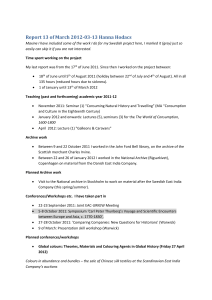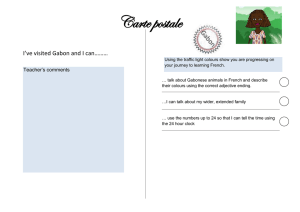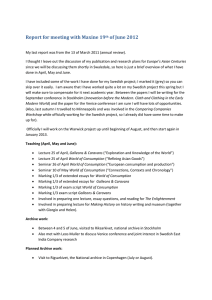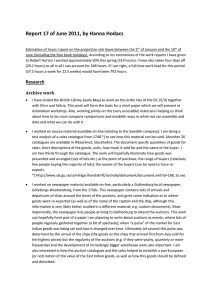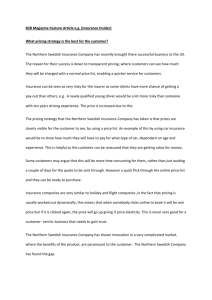Report 13 of March 2012-03-13 Hanna Hodacs
advertisement
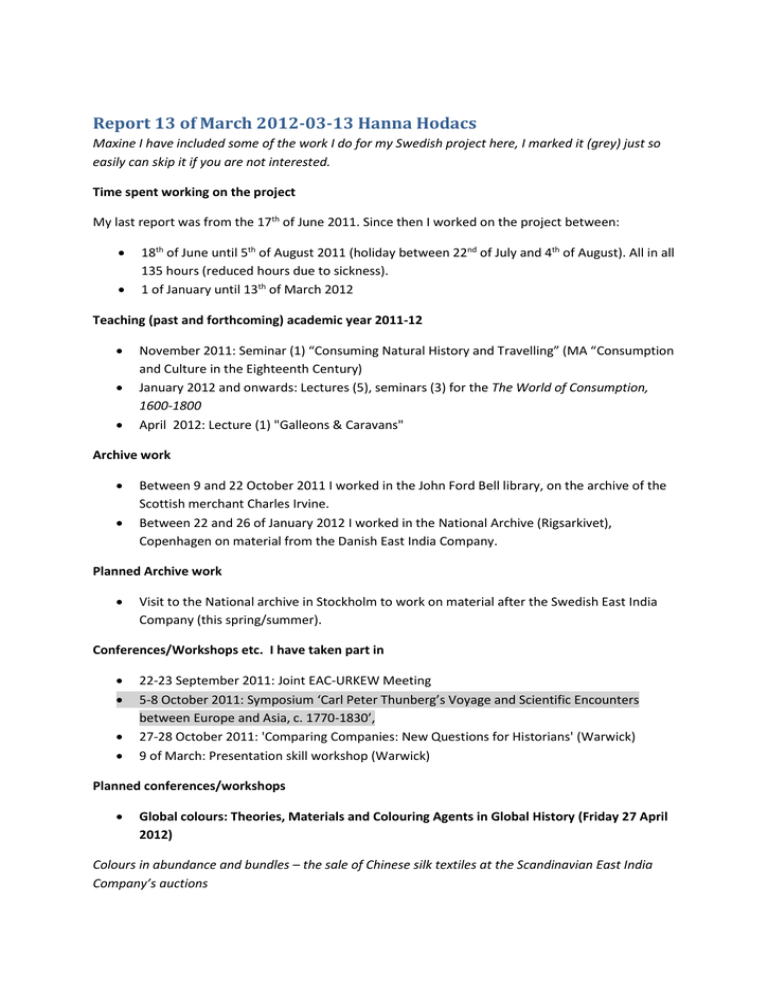
Report 13 of March 2012-03-13 Hanna Hodacs Maxine I have included some of the work I do for my Swedish project here, I marked it (grey) just so easily can skip it if you are not interested. Time spent working on the project My last report was from the 17th of June 2011. Since then I worked on the project between: 18th of June until 5th of August 2011 (holiday between 22nd of July and 4th of August). All in all 135 hours (reduced hours due to sickness). 1 of January until 13th of March 2012 Teaching (past and forthcoming) academic year 2011-12 November 2011: Seminar (1) “Consuming Natural History and Travelling” (MA “Consumption and Culture in the Eighteenth Century) January 2012 and onwards: Lectures (5), seminars (3) for the The World of Consumption, 1600-1800 April 2012: Lecture (1) "Galleons & Caravans" Archive work Between 9 and 22 October 2011 I worked in the John Ford Bell library, on the archive of the Scottish merchant Charles Irvine. Between 22 and 26 of January 2012 I worked in the National Archive (Rigsarkivet), Copenhagen on material from the Danish East India Company. Planned Archive work Visit to the National archive in Stockholm to work on material after the Swedish East India Company (this spring/summer). Conferences/Workshops etc. I have taken part in 22-23 September 2011: Joint EAC-URKEW Meeting 5-8 October 2011: Symposium ‘Carl Peter Thunberg’s Voyage and Scientific Encounters between Europe and Asia, c. 1770-1830’, 27-28 October 2011: 'Comparing Companies: New Questions for Historians' (Warwick) 9 of March: Presentation skill workshop (Warwick) Planned conferences/workshops Global colours: Theories, Materials and Colouring Agents in Global History (Friday 27 April 2012) Colours in abundance and bundles – the sale of Chinese silk textiles at the Scandinavian East India Company’s auctions Abstract In this paper I will discuss Chinese silk textiles (e.g. Damask, Taffeta and Paduasoy) for sale at the Scandinavian East India Company’s auctions (from 1730s and onwards). I will primarily discuss the textiles imported by Danish and the Swedish companies but I will also include some comparisons with the other European companies' assortments. I will particularly focus on the descriptions and references to colours in some of the remaining sales catalogues: What can we learn from the names of colours used here? Did names/references vary between different companies? Did the differentiation of colours increase over time, or did some colours disappear while others were added? I will also discuss the compilation of colours in different lots/bundles of textile for sale: What was the relation between the variations of colours in a lot for sale and the price it caught? One overall ambition with the paper is to illuminate the role of the Scandinavian companies in providing consumer at home and (maybe largely) in other European countries with silk textiles: Can an approach focusing on colours help understand the European market for Chinese silk and the existence of national variations? The paper is a result of research conducted within the ERC project 'Europe’s Asian Centuries: Trading Eurasia 1600-1830', based at the University of Warwick. Linnaean Worlds: Global Scientific Practice During the Great Divergence, 1750-1850, Pittsburgh 05/04/2012 (mainly for Swedish project) Between metropolitan and colonial natural history: Swedish naturalists in London, 1760–1810 Abstract London became a centre for European as well as global natural history in the second half of the eighteenth century, a development which reflected the growing importance of Britain as an expanding colonial power and trading nation. Linnaeus’ taxonomy and nomenclature was central to this development, and several Swedish naturalists (many of them former students of Linnaeus) became engaged in organizing and administrating natural history collections in the metropolis as well as exploring natural history in the outposts of the British Empire (e.g. Daniel Solander, 1733– 1782, Jonas Carlsson Dryander, 1748–1810, and Adam Afzelius, 1750–1837). In this paper I will discuss the roles these individuals played. This includes discussing their activities as administrators of large quantities of natural history material, as secretaries handling communications and organizing meetings and, and as bibliographers and authors of species descriptions. One aim with the paper is to understand these individuals’ movements between Sweden and England, against both the backdrop of London’s role as an imperial centre and in the light of their career ambitions. One central question is: what roles did national identities and scientific personae [Lorraine Daston & Otto Sibum] play in directing these naturalists at work? The paper will be based on material located at the Linnaean Society in London, in the University of Uppsala Library and in printed editions of letters to and from above mentioned naturalists. Innovation before the Modern. Cloth and Clothing in the Early Modern World, Nordiska Museet, Stockholm, 27-29 September 2012 (Proposal made for paper, same as for global colour workshop, will find out if accepted on the 15 of March) ‘Enlightenment from below’, Los Angeles on 7-8 Dec 2012 (Same paper as for Pittsburgh conference, see above). Work in progress I am currently working on two papers, one for my Swedish project on global knowledge and Swedish naturalists in London, and one for the paper for the Global Colour workshop. (I mentioned the first paper since strictly speaking I should be working on the Warwick project this spring, however since I worked on the Warwick project this autumn I am making up for time I lost on my Swedish project). In the second paper I am going to develop approaches and conclusions from the mini-paper I presented at the EAC-URKEW meeting, I am going to include material from the Danish archive. Pending on the response I get on my paper, further work on the Danish material, and results from my planned visit to the National Archive in Stockholm I will spend May and June working out a detailed research plan (for our meeting in Swaledale). At the moment I envision working further on the auctions, I also think it would be possible and fruitful to map out some of the networks engaged in the re-export of goods brought to Copenhagen and Gothenburg. I would also like to write something on the quality control of tea, brought in by the Swedish company but re-exported to Rotterdam. A preliminary plan for a (short) monograph on the Scandinavian East India trade might look something like this. Peripheral Emporiums – the Scandinavian trade with Asia in the 18th Century 1. Introduction On what distinguished the Scandinavian companies: Neutrality Slim line organisations The proximity to strong consumer markets 2. The Auctions Intro: On the auctions in Copenhagen and Gothenburg in comparison with what we know about other East India Company auctions Timing - Regularity The auction as an event o Setting prices o Introducing new goods 3. Networks involved in re-exports Intro: On Baltic merchant houses and the Scottish connections On the buyers at the auction Where did they re-export go to o Case study Quality control
